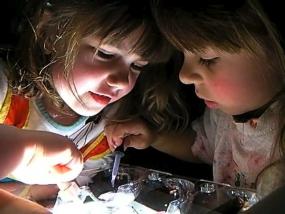Girls Experiment with Color Mixing Over a Light

Let’s listen to how three girls talk "science" as they use eyedroppers to create colored liquids. The close proximity of the girls, each with her own eyedropper, making new colors that are under-lit by the overhead projector - all of these factors support thinking out loud as they express their surprise, their predictions, and their methods of making new colors. The teacher poses interesting questions to help the children reflect on what was done and what could be done during this investigation of mixing colors. Here are a few comments of note: Child - - "Look while it's mixing it does this kinda ....” (She does not provide a word here.) Teacher - "Interesting, it makes a little ...” (Teacher pauses in hopes that the child will provide a phrase, such as "cloudy stuff".) But the child does not offer her description, so the teacher moves on to ask, "And does that go away?" Her question is a provocation for the child to think about why the cloudy look goes away. Pay particular attention to the precise way the girls describe the colors they create; for example, "kinda reddish pink" and "pinkish purplish." From whence comes this precision, the precision of a real close investigation? Most likely the children feel the need to distinguish pink from reddish pink from pinkish purplish because they started with pink and then modified the original pink; therefore it deserves a new name. When we give children control over transformations, they focus more intently on what is happening and invent new nomenclature, so that they can communicate their achievements and goals to each other. The teacher understands that this activity has great potential, not just to occupy the children but also to reflect on the relation between a process and an effect. So when one child says, "We made pink!" the teacher asks, "How did you do that?" One girl offers time as the cause: "We let it go for a second," then changes that to "a minute," perhaps thinking effects such as color change are not instantaneous. The teacher provides the counterfactual as all good teachers do, "But how did you make pink when we don't have pink paint up here?" The girl on the left says, with great mystery in her voice, "We don't know." The girl on the right supports this stance saying, "Scientists don't know what happened to dinosaurs, so they probably don't know what happens to colors when they mix." How can one argue with that? Listen as the girls continue to put their actions into words. Decide for yourself if you think the children make a transition from naming new colors to explaining the process by which new colors are made. Also, think about the strategies the teacher uses to facilitate the flow and the thinking in this investigation. Length of video: 5 minutes 11 seconds Keywords: Fours, Paint, Children-Teacher, Experimentation, Science, Colors
